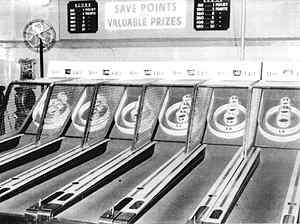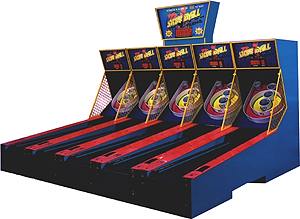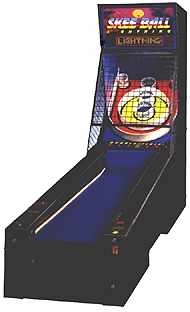
Skee-Ball game ball (Skee-Ball, Inc.)
Everyone has their favorite thing about summer. For some, it's the beach; for others, those weekend getaways. For me, though, summer means I'll be making a few trips to Coney Island, and going to Coney means I'll be playing Skee-Ball, and playing Skee-Ball means -- well, let's just say that Skee-Ball provides one of the most perfectly realized little inconspicuous moments that life has to offer.
To explain: Skee-Ball, as you probably know, is that coin-operated game where you roll a series of nine balls, one at a time, up a gently inclined lane that has a hump at the far end. The ball sort of launches off of the hump and then lands in one of several holes -- the farther away the hole is, the more points that hole is worth. It's a swell game, but the key moment for me is when I drop my coin in the slot, which releases the nine balls down a ramp -- the balls are all released at once and proceed down the ramp in unison, one after the other, so they all come to a near-simultaneous stop when the bottom ball reaches the base of the ramp, which produces a spectacularly satisfying Click! sound that resonates throughout the room. The appeal of the click (which is actually comprised of eight separate and distinct mini-clicks, which are separated by a nanosecond or so as each ball collides with the one in front of it) is hard to describe, but it's one of those exquisitely perfect noises that's exciting and comforting all at once.
The click is also an unmistakably organic sound, because Skee-Ball balls are made of wood -- or rather "a wood compound, which is basically compressed sawdust," as Skee-Ball Executive Vice President Mark Kane explains. The brown balls, which usually have the battle-scarred remnants of a stripe near the center, measure three and an eighth inches in diameter and weigh about five ounces. They're lovely little items -- so lovely, in fact, that it's sort of amazing that the company hasn't switched to plastic, which must surely be cheaper. I mention this to Kane, who says, "We've been very sensitive to preserving the traditional feel of the balls, so we have no plans to change the material."
 |
Skee-Ball was invented in 1909 by a fellow named Jonathan D. Estes, who, as Kane puts it, "was just looking for something to do." The lanes were originally 36 feet long, a distance that made the game almost exclusively a male activity until 1928, when they were shortened to 14 feet, making Skee-Ball accessible to all and greatly expanding its popularity. (Further shortening would eventually reduce the length to 10 feet.) The Skee-Ball brand has changed hands several times, most recently in 1985, when the current ownership team took over. Their timing turned out to be perfect, because the explosion of "regional family entertainment centers," as they say in the biz (or, as Kane puts it, "Your Chuck E. Cheeses, your Peter Piper Pizzas, those kind of places") led to a major sales jump in the late '80s and early '90s.

For me, however, Skee-Ball will always be too closely associated with Coney Island for me to play it in some lame-o family restaurant. But since I only go to Coney during the summer, what am I supposed to do the rest of the year? One possible answer: I could have a Skee-Ball lane installed in my home. The price is a little steep -- somewhere around $4000, according to Kane -- but I'm considering it. Not only would I get to savor the magnificent Skee-Ball click on a year-round basis, but the machine would eventually pay for itself as my houseguests got addicted to its charms and kept tossing more quarters in the slot.
(Skee-Ball, Inc., 121 Liberty Lane, Chalfont, PA 18914)